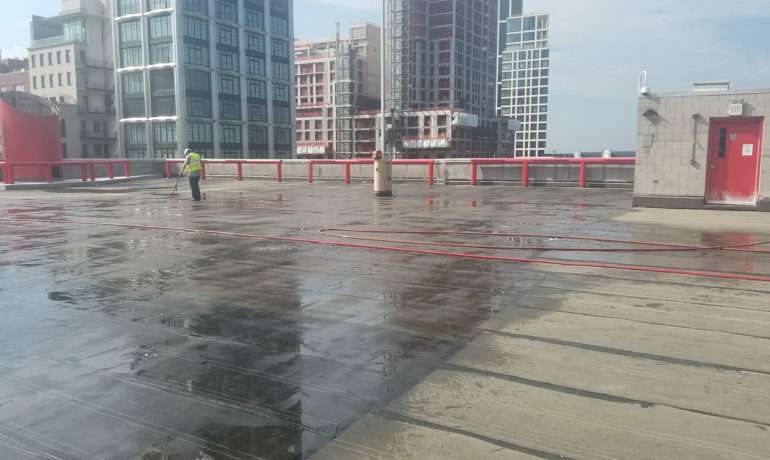Flat or low sloped roofing allows for better energy efficiency for businesses, but they’re more prone to leaking than pitched roofs. Flat roof leak detection can help uncover possible leaking areas on your building, but many business owners don’t understand the appeal of the diagnostic and how effective it is. Below, we’ll discuss what electronic flat roof leak detection is, and the four most misunderstood facts about it.
What is Electronic Leak Detection?
Electronic leak detection (ELD) is a testing protocol for uncovering breaches and weak points in the roof covering that are potential leak sources. It’s effective for flat roofs and has an extremely high degree of accuracy.
The Three Methods
ELD can be performed with one of three methods, high voltage or low voltage.
High Voltage Leak Detection
Also known as “dry roof” or “spark testing”, this is the most versatile method for roof leak detection as it allows our technicians to test on horizontal and vertical surfaces. This method is used to detect leaks under dry conditions using high-voltage technology.
Low Voltage Leak Detection
Also known as Electric Field Vector Mapping (EFVM), Low-voltage Integrity Testing (LVIT), or just LV Testing, this method detects leaks under wet conditions using low-voltage technology.
IntegriScan Low Voltage Leak Detection
The IntegriScan is an all-new form of low voltage leak detection. It detects leaks on horizontal and vertical surfaces and is the only method capable of testing conductive membranes such as black EPDM.
As effective as these processes are, there are many misconceptions about how they work. Below are the top four myths about ELD:
1. It Can Cause Damage to Your Roof
Introducing large volumes of water to your roof, as in the case of flood testing, can cause damage to your roof’s drain system and excessive leaking in your building. Electronic leak detection, in some cases, uses minimal water and is far safer than almost all other leak detection methods.
2. It Doesn’t Pinpoint Damage
Any leak detection method can be misused and lead to false positives or poor leak location. Provided the inspection is done by a trained and certified professional, electronic roof leak detection will pinpoint leaks very accurately. By comparison, flood testing can only indicate that there is a leak, but not where the actual point of intrusion is.
3. It Only Detects Active Leaking
Contrary to popular belief, electronic leak detection can uncover weakened areas of your roof that may begin leaking soon, ultimately saving you money on repair costs and minimizing property damage.
4. It’s Too Expensive
Electronic leak detection has developed into a quick and painless process. Many building owners find that the inspection is well worth the relatively low cost, given how much it can save you in damages to your building and repairs.
Why You Should Choose ELD Over Traditional Methods
ELD is more accurate than many other testing methods, can pinpoint exact locations of a leak, can uncover weakened roof membranes, and is much safer than traditional methods. ELD providers like ATS offer a detailed report of your roof health, allowing you to optimize repairs while keeping your building safe from damages.
For more information about ELD or to schedule an electronic flat roof inspection for your building, contact one of our highly-trained professionals today.

